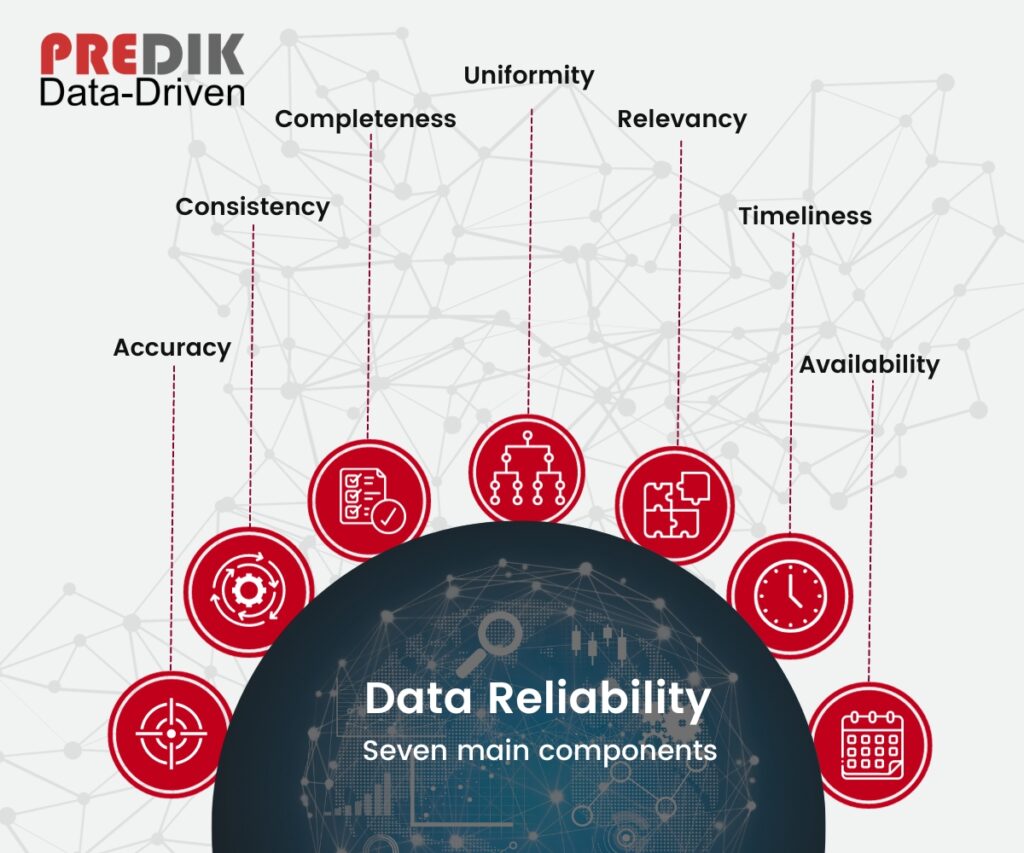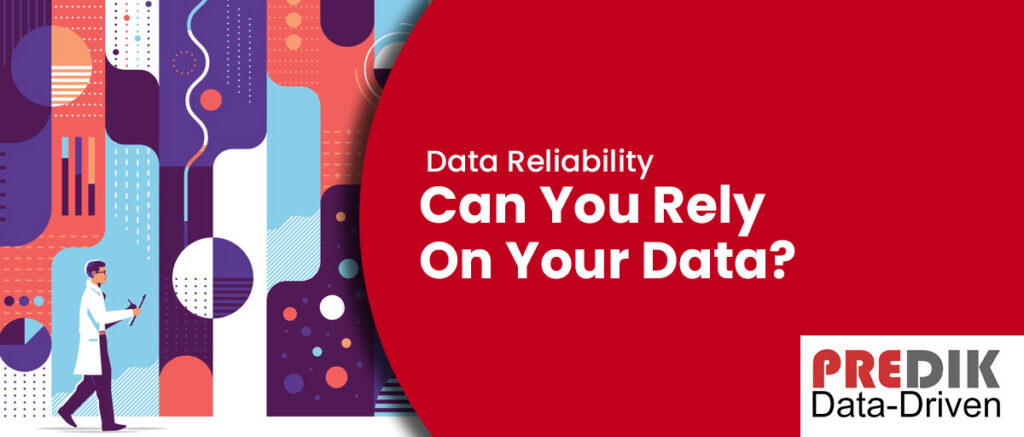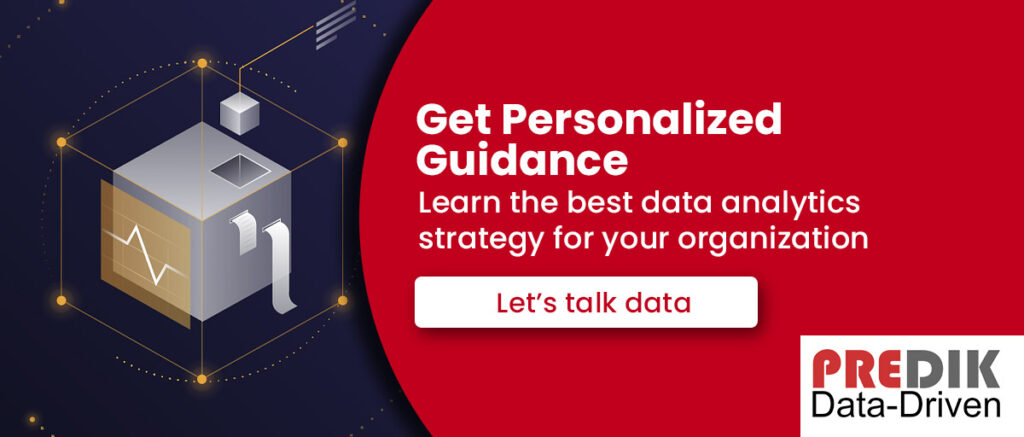Even though most companies recognize the importance of data to their organizational and business success, more than 90% confirm facing challenges in using their data effectively.
One of the main issues is data reliability. A recent survey revealed that only 36% of companies truly trust their data when making crucial business decisions. To make matters worse, one in three companies doubts their teams’ ability to understand and use data appropriately.
In this article we will cover:
What is data reliability?
Data reliability measures how much an organization can trust data to be accurate and complete throughout its lifecycle, emphasizing its integrity. It provides the necessary basis for creating data trust within an organization, which is key for making informed decisions.

It is worth mentioning that data reliability depends on seven main components:
Accuracy
Accuracy refers to the degree to which the data reflects the reality of any given topic.
Consistency
Consistency refers to the data’s ability to produce the same results under the same conditions over time. This means the data should be accurate and complete and represented the same way across all systems and applications.
Completeness
Completeness refers to the extent to which the available data is comprehensive and includes all the necessary information. If the data is complete and easy to understand, it becomes usable and can lead to unintentional incorrect decisions.
Uniformity
Uniformity ensures data adheres to a consistent structure, preventing errors.
Relevancy
Relevancy is essential to have a clear purpose for collecting all the data and information. The data must be suitable for its intended use. If the data is not relevant, it will have no value.
Timeliness
Timeless is crucial in data management, as outdated information can waste resources.
Availability
Availability refers to the accessibility of an organization’s data to its users whenever necessary.
What is the impact of data reliability on companies?
Having reliable data is crucial for making informed decisions, reducing guesswork, and delivering accurate insights. For example, marketing and commercial teams can use this data to enhance customer engagement strategies and fine-tune marketing tactics, while development teams can create effective product development cycles.
Companies that trust their data can optimize their operations and stay ahead of the competition.
Better customer experience
With reliable data, decision-makers can make informed and timely decisions, leading to more efficient operations and better customer experiences.
What happens if your marketing team wants to engage personalization through different channels (both digital and physical)? Well, reliable data helps avoid common pitfalls like sending promotional campaigns to the wrong audience or making unnecessary activations on their POS.
We recommend you reading: Understanding Competitive Data: Benefits, Uses and Sources
Financial impact
Organizations can improve revenue, reduce expenses, and grow by prioritizing data quality. After all, trustworthy data enables the identification of profitable initiatives and the avoidance of costly missteps.
Improve supply chain processes
Data reliability also plays a significant role in the supply chain, including data assets, pipelines, infrastructure, and users. A robust data reliability solution allows managers to monitor these components and correlate information to identify and prevent potential issues, ensuring smooth and uninterrupted operations.

Comply with legal and ethical standards
Companies must comply with user privacy laws; the first step is to have reliable data. Inaccurate or unreliable data can cause legal issues and damage customer trust.
A step to a data-driven approach
Consistently low data reliability affects any organization’s confidence in making data-driven decisions and entering a more advanced data analytics stage.
When business teams cannot trust their data, they opt for intuition rather than well-founded insights, leading to suboptimal decisions. Therefore, maintaining high data reliability is essential for fostering an organization’s data-driven decision-making culture.
We recommend you reading: Is Your Company Data-Driven?
The origins of data reliability issues
Human errors can occur during data entry, leading to inconsistencies and inaccuracies in any dataset. Technical problems, such as system malfunctions or data corruption, can result in data loss or distortion. External factors, such as changes in data sources or unforeseen events, can also contribute to data quality issues. Finally, poor data management practices, such as insufficient data governance or inadequate data storage, can allow errors to persist and worsen over time.
How can you identify unreliable data within your organization?
Several indicators can point you in the right direction if you suspect data reliability issues. These indicators can be categorized into the following key areas:
Data sourcing: Examine the source of the data. Is it from a reputable organization or an unknown entity? Is there transparency in how data was collected? (Learn how you can get Big Data solutions based on reliable and enriched data).
Collection Methodology: Analyze how your data was collected. Was it gathered systematically or randomly? Were there any potential biases or limitations in the data collection process?
Outliers: Identify values or elements that fall outside the expected range. Do any extreme values seem out of place?
Inconsistencies within data: Look for conflicting or contradictory information within the dataset. Do different parts of the data tell the same story, or are there discrepancies?
Missing information: Could significant gaps affect the data’s completeness and accuracy?
Historical vs. new data: If historical data is available, compare it with new data to detect unexplained changes. Are there any unusual shifts or deviations from historical trends?
Duplicate records: Check for duplicate records within the dataset. Duplicate entries can distort results and lead to inaccurate conclusions.
Unusual patterns: Are there any unique patterns that suggest unreliable responses?
Enhancing Your Data Reliability: A Continuous Process
Data reliability is not a one-time achievement but an ongoing process that requires continuous monitoring and improvement. For that reason, companies should implement some good practices:
Data policies: Establish clear policies and guidelines for data collection, processing, storage, and safeguarding. These policies should define data quality standards and outline procedures for identifying and rectifying data issues.
Evaluate your data provider: When sourcing data externally, carefully evaluate the reliability of the data provider. Reputable data providers will provide comprehensive documentation, data testing opportunities, and ongoing support.
For example, at PREDIK Data-Driven we have more than 14 years providing reliable data and proven analytics methodologies for worlwide companies from all industries. Learn more>>
Documentation processes: Thoroughly document all data sets, including data collection procedures, transformation processes, known limitations, and relevant metadata.
Data Governance: Implement a robust data governance framework to oversee data quality, ensure policy compliance, and promote a data-driven culture within the organization.
Are data quality and data reliability the same?
It is easy to confuse “data quality” and “data reliability. ” Although these terms are sometimes employed interchangeably, they involve different, although overlapping, aspects of data management.
It is crucial to understand that “data quality” refers to the inherent characteristics of data. On the other hand, “data reliability” maintains those qualities in a dynamic and often complex operational context. Understanding this distinction is essential for effectively managing and leveraging data as a strategic asset in today’s data-centric world.
| Aspect | Data Quality | Data Reliability |
|---|---|---|
| Definition | Refers to the accuracy, completeness, consistency, and relevance of data. | Extends beyond data quality to include stability and dependability of data over time and under various conditions. |
| Focus | Concentrates on the intrinsic properties of data such as correctness, currentness, and uniformity. | Focuses on the robustness and performance of data management systems in maintaining data quality in dynamic environments. |
| Importance | Essential for ensuring that data accurately represents real-world entities or events. | Critical for adapting to the fluid nature of modern data environments and ensuring data remains high-quality over time. |
| Key Characteristics | Accuracy, completeness, consistency, relevance. | Stability, dependability, adaptability. |
| Applications | Important in any data-driven decision-making process. | Particularly relevant in environments with continuous data generation and updates. |
| Monitoring | Ensures data meets quality standards at a given point in time. | Involves continuous monitoring and management to maintain quality amidst changes and updates. |
| Challenges | Ensuring data is free from errors, up-to-date, and uniformly formatted. | Handling data drifts, ensuring data integrity during transfers, providing near real-time alerts. |
| Outcome | High-quality data that is reliable for static analyses and reporting. | Data that remains high-quality and reliable in near real-time and dynamic processes. |
Final thoughts
Making decisions based on unreliable information can lead to costly mistakes, whereas reliable data can provide a competitive advantage. That is why measuring and comprehending data is vital for improving the precision and consistency of your insights, thus enabling you to make informed and better decisions.



